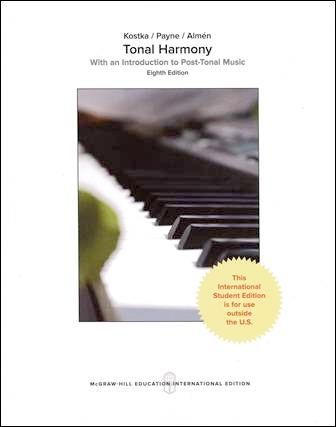(eBook) Workbook for Tonal Harmony: With an Introduction to Post-Tonal Music 8/e
- ◉ VitalSource◉ 閱讀期限:Lifetime
售價
$
1,000
- 電子書
- ISBN:9781260179255
- 作者:Stefan Kostka, Dorothy Payne, Byron Almén
- 版次:8
- 年份:2018
- 出版商:McGraw-Hill
- 頁數/規格:電子書
書籍介紹
本書特色
目錄
►VitalSource 電子書購買須知:
Description
Grade Levels: 9-12
Leading Text, Straightforward Approach to AP Music Theory
For more than two decades Tonal Harmony has been the leading text for AP Music Theory students and music majors. Used at nearly 800 schools, Tonal Harmony has been consistently praised for its practicality and ease of use for student and teacher alike. The straightforward approach is supported by well-chosen examples and thoughtful exercises, and the total presentation is compatible with differing teaching styles and theoretical points of view.
This edition also includes:
- 閱讀期限:Lifetime
- 電子書兌換碼將於 3-5 個工作天,寄送至「序號寄送 E-mail」所填寫的信箱。
- 根據消費者保護法第 19 條第 1 項規定,本產品為數位內容,售出後恕不接受退貨或退款。
- 本產品僅限台灣境內使用,海外 IP 無法註冊或啟用。
- 電子書平台登錄與註冊說明 (eText-Register.pdf)。
- 電子書平台操作手冊 (eText-Manual.pdf)。
- 如有任何問題,請 Email 至 ebook@tunghua.com.tw。
Description
Grade Levels: 9-12
Leading Text, Straightforward Approach to AP Music Theory
For more than two decades Tonal Harmony has been the leading text for AP Music Theory students and music majors. Used at nearly 800 schools, Tonal Harmony has been consistently praised for its practicality and ease of use for student and teacher alike. The straightforward approach is supported by well-chosen examples and thoughtful exercises, and the total presentation is compatible with differing teaching styles and theoretical points of view.
This edition also includes:
- A student workbook (available in print and digital format.) All audio excerpts needed to complete the exercises are embedded in the eBook workbook.
- Connect® with SmartBook™ adaptive reading experience.
- Embedded audio, in the SmartBook, featuring recordings of every example from music literature found in the text, performed using the same instrumentation seen in the examples.
- Interactive drills embedded in the Smartbook, which offer students a wealth of hands-on practice as they read.
Features
- Connect: A highly reliable, easy-to-use homework and learning management solution that embeds learning science and award-winning adaptive tools to improve student results.
- With this new edition, twenty-first century technology meets a time-honored tradition.
- Now available in McGraw-Hill Education’s Connect®, students are better equipped to understand and master the vocabulary of music efficiently, allowing them to move on more quickly to advanced musical skill-building.
Table of Contents
Part I Fundamentals
Chapter 1: Elements of Pitch
Chapter 2: Elements of Rhythm
Chapter 3: Introduction to Triads and Seventh Chords
Chapter 4: Diatonic Chords in Major and Minor Keys
Part II: Diatonic Triads
Chapter 5: Principles of Voice Leading
Chapter 6: Root Position Part Writing
Chapter 7: Harmonic Progression
Chapter 8: Triads in First Inversion
Chapter 10: Cadences, Phrases, Periods, and Sentences
Chapter 11: Two-Part Tonal Counterpoint
Chapter 12: Non-Chord Tones 1
Chapter 13: Nonchord Tones 2
Part III: Diatonic Seventh Chords
Chapter 14: The V7 Chord
Chapter 15: Other Diatonic Seventh Chords
Part IV: Chromaticism
Chapter 16: Secondary Functions 1
Chapter 17: Secondary Functions 2
Chapter 18: Modulations Using Diatonic Common Chords
Chapter 19: Some Other Modulatory Techniques
Chapter 20: Larger Forms
Part V: Chromaticism 2
Chapter 21: Mode Mixture and the Neapolitan
Chapter 22: Augmented Sixth Chords
Chapter 23: Enharmonic Spellings and Enharmonic Modulations
Chapter 24: Further Elements of the Harmonic Vocabulary
Chapter 25: Tonal Harmony in the Late Nineteenth Century
Part VI: An Introduction to Twentieth-Century Music
Chapter 26: Materials and Techniques
Chapter 27: Post-Tonal Theory
Chapter 28: New Directions
Part I Fundamentals
Chapter 1: Elements of Pitch
Chapter 2: Elements of Rhythm
Chapter 3: Introduction to Triads and Seventh Chords
Chapter 4: Diatonic Chords in Major and Minor Keys
Part II: Diatonic Triads
Chapter 5: Principles of Voice Leading
Chapter 6: Root Position Part Writing
Chapter 7: Harmonic Progression
Chapter 8: Triads in First Inversion
Chapter 10: Cadences, Phrases, Periods, and Sentences
Chapter 11: Two-Part Tonal Counterpoint
Chapter 12: Non-Chord Tones 1
Chapter 13: Nonchord Tones 2
Part III: Diatonic Seventh Chords
Chapter 14: The V7 Chord
Chapter 15: Other Diatonic Seventh Chords
Part IV: Chromaticism
Chapter 16: Secondary Functions 1
Chapter 17: Secondary Functions 2
Chapter 18: Modulations Using Diatonic Common Chords
Chapter 19: Some Other Modulatory Techniques
Chapter 20: Larger Forms
Part V: Chromaticism 2
Chapter 21: Mode Mixture and the Neapolitan
Chapter 22: Augmented Sixth Chords
Chapter 23: Enharmonic Spellings and Enharmonic Modulations
Chapter 24: Further Elements of the Harmonic Vocabulary
Chapter 25: Tonal Harmony in the Late Nineteenth Century
Part VI: An Introduction to Twentieth-Century Music
Chapter 26: Materials and Techniques
Chapter 27: Post-Tonal Theory
Chapter 28: New Directions


